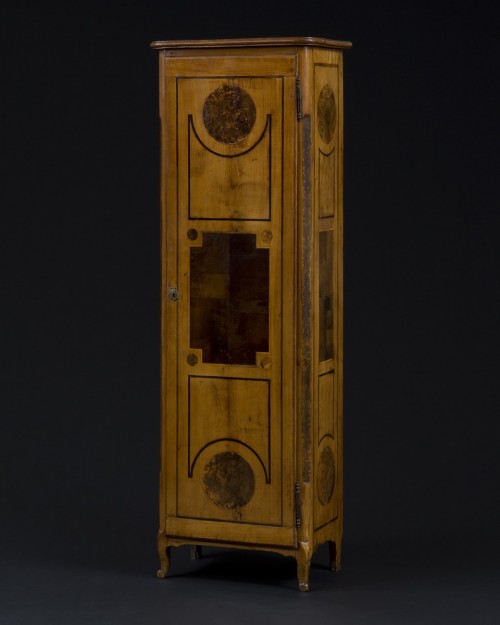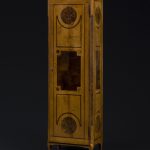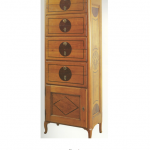9823 A MOST UNUSUAL CHERRY WOOD AND INLAID LATE LOUIS XV SEMANIER BY JEAN FRANCOIS HACHE Grenoble. Dated 1777. Measurements: Height: 63 3/4 inches (162 cm) Width: 20 inches (51 cm) Depth: 12 inches (30 cm)

-
Figure 1
Research
Of cherry wood inlaid with burr maple, ebony and sycamore. The molded cornice above a single door is inlaid with a system of geometric shapes. The door opens to reveal a fully fitted interior with seven drawers, each centered by a plain brass knob. The sides similarly inlaid and the whole raised on four short cabriole legs.
Marks:
Bears printed paper label:
À Grenoble, Place Claveyson, Janvier 1777.
Jean François Hache represents the fourth generation in a family of famed cabinetmakers from Grenoble, France, who worked throughout the end of the 17th century and the entirety of the 18th century. The dynasty began with Noël Hache (1630-1675), the son of a master baker who chose not to enter the family business, but rather studied veneering in the workshop of a Calais master. This northern region of France was directly influenced by the marquetry of Belgium and The Netherlands. Eventually, Noël set up his own workshop in Toulouse and, upon his death, it was taken over by his son Thomas. Thomas Hache then moved the atêlier to Grenoble. His only son, Pierre, worked with him as did his grandson, Jean-François.
Jean-François Hache (1730-1796) is probably the most famous of the Hache craftsmen. In 1756 he spent some time in Paris where he was very much influenced by the Louis XV style and particularly by the work of Jean-François Oeben. He gradually took the baton at the family workshop and around 1760 began to incorporate more simplified forms and intricate marquetry into his designs.
A strong keynote of Hache’s work is his use of bold and unusual geometric inlaid forms. The distinctive nature of these forms is accentuated by the fact that he placed them within late Louis XV rococo furniture prototypes. The interesting and highly successful tension this created makes Hache’s work unique.
The present semanier was executed by Jean-Francois Hache in 1777 and bears a printed label on which the date, janvier 1777, has been filled in by hand. The label names the people of import who commissioned Hache and advertises the workshop’s impressive range of production. According to René Fonvieille, biographer of the Hache dynasty, the labels used by the workshop can be categorized into fourteen types, the present label belonging to type IX.1
A chifonnier by Hache circa 1770-1780, now in the Collection Musée Dauphinois (figure 1) is closely related in form and design. The use of four cabriole legs which terminate in a pastille foot, appears on both this piece and the present semanier and is a signature of Hache’s work. The sides of the chifonnier are also decorated with a simplified geometric inlaid design much like the door and sides of the present semanier.
Footnotes:
1. Hache, Noël, and Marianne Clerc. Hache ébénistes à Grenoble: [Exposition Hache Ebénistes à Grenoble présentée au Musée Dauphinois (octobre 1997 – octobre 1998)]. Grenoble: Glénat, 1997. 71.



Comments are closed.